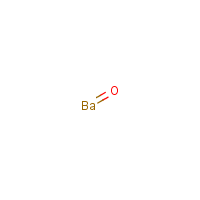Barium oxide
Agent Name
Barium oxide
CAS Number
1304-28-5
Formula
Ba-O
Major Category
Metals

Synonyms
Barium monoxide; Barium protoxide; Baryta; Calcined baryta; Oxyde de baryum [French]; [ChemIDplus] UN1884
Category
Metals, Inorganic Compounds
Description
White to yellowish-white solid; Soluble in water; [Merck Index] Beige powder; [Aldrich MSDS]
Sources/Uses
Used to dry gases and solvents and to make lubricating oil detergents and barium methoxide; [Merck Index] Used as a drying agent for gasoline and solvents; [CAMEO]
Comments
Highly alkaline; Absorbs moisture and carbon dioxide from air; Produces barium hydroxide and much heat on contact with water; [Merck Index] Reacts violently with water posing fire and explosion hazard; A skin, eye, and respiratory tract irritant; Short-term exposure may affect the nervous system and cause hypokalemia (leading to cardiovascular and muscular disorders); [ICSC] Reacts with water evolving energy and forming barium hydroxide (corrosive); A skin, eye, and respiratory tract irritant; [CAMEO] Causes somnolence and tetany in intraperitoneal lethal-dose studies of mice; [RTECS] Causes burns; Inhalation may cause corrosive injuries to upper respiratory tract and lungs; Toxic by ingestion; Targets heart, nerves, kidney, GI tract, bone marrow, spleen, and liver; [Aldrich MSDS] See "Barium."
Biomedical References
Exposure Assessment
TLV (ACGIH)
0.5 mg/m3, as Ba
PEL (OSHA)
0.5 mg/m3, as Ba
MAK
0.5 mg/m3, as Ba, inhalable fraction(soluble compds)
IDLH (NIOSH)
50 mg/m3, as Ba
Adverse Effects
Nephrotoxin
Yes
Dermatotoxin
Skin burns
ACGIH Carcinogen
Not Classifiable
Diseases, Processes, and Activities Linked to This Agent
Processes
Industrial Processes with risk of exposure: